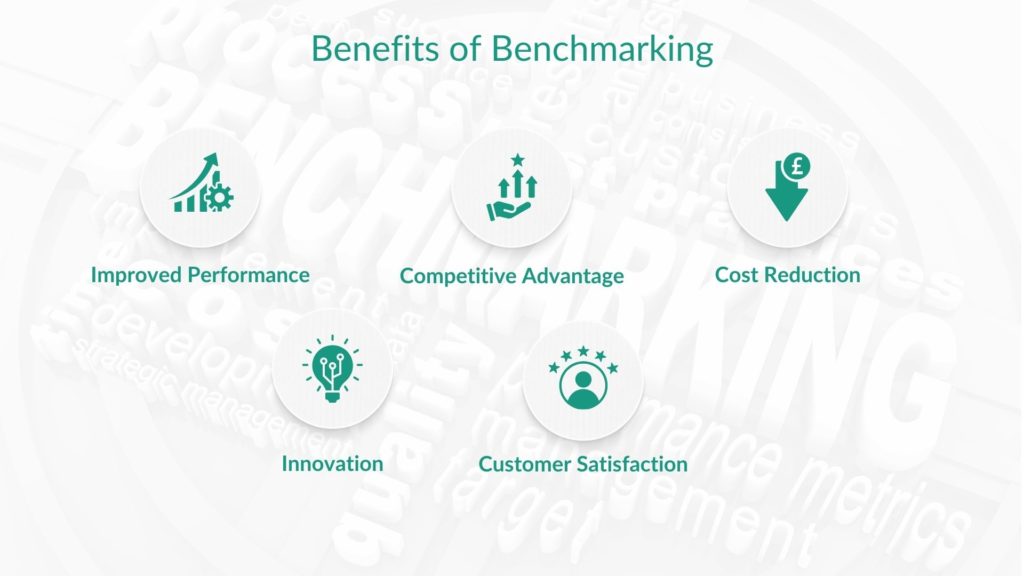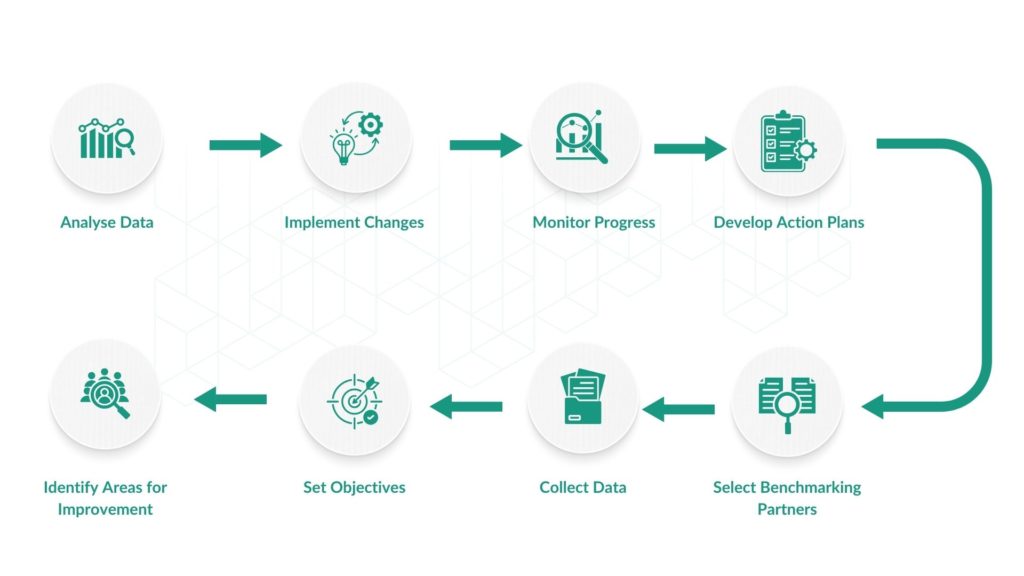Have you ever wondered how leading companies excel in everything they do? Whether achieving stellar customer satisfaction, improving operational efficiency, or staying ahead of the competition, benchmarking is one secret behind their success. “What is benchmarking in business?” This solution allows companies to measure performance, analyse shortcomings, and set goals for excellence. In this guide, we’ll explore everything from the basics of benchmarking to its benefits, types, and practical steps for implementing it in your business.
What is Benchmarking in Business?
Benchmarking in business refers to measuring and comparing an organisation’s performance, processes, or products against industry standards, competitors, or best practices. It helps companies understand how well they perform compared to others and identify areas for improvement. Benchmarking provides valuable insights to drive strategic decision-making and increase efficiency by identifying performance gaps.
Benefits of Benchmarking

Why should businesses invest time and resources in benchmarking? Here are the primary benefits:
- Improved Performance: By identifying performance gaps, companies can make informed decisions to enhance efficiency and productivity.
- Competitive Advantage: Benchmarking allows companies to understand their strengths and weaknesses relative to competitors, providing an edge in the market.
- Cost Reduction: Benchmarking helps businesses identify inefficiencies and find cost-effective solutions to improve operations.
- Innovation: By studying industry leaders, companies can adopt innovative practices and stay ahead of the curve.
- Customer Satisfaction: Benchmarking often involves understanding customer expectations, which can help businesses improve service delivery and increase customer loyalty.
Why is Setting Benchmarking Important?
Benchmarking plays a crucial role in business success for several reasons:
- Continuous Improvement: It encourages companies to constantly improve by measuring their performance against external standards.
- Setting Realistic Goals: Benchmarking provides a solid foundation for setting achievable goals based on industry best practices.
- Risk Mitigation: By monitoring competitor movements and market trends, businesses can mitigate potential risks and avoid stagnation.
- Resource Allocation: Understanding the performance gaps can help businesses prioritise resources and focus on the most impactful areas.
What are the Four Types of Benchmarking?
Benchmarking can be categorised into several types based on the focus and scope of comparison. Here’s a detailed overview of the most common types:
1. Internal Benchmarking
Internal benchmarking compares processes and performance within the same organisation. This type of benchmarking is helpful for companies with multiple departments, divisions, or teams, as it identifies best practices within the organisation.
Example: Comparing the sales performance of different regional teams within the same company.
Benefits:
- Easy to access data.
- Promotes consistency across departments or branches.
- Encourages sharing of best practices internally.
2. Competitive Benchmarking
Competitive benchmarking focuses on comparing a company’s performance against its direct competitors. This type of benchmarking helps businesses understand how well they are performing compared to their rivals and gain insights into competitive advantages or gaps.
Example: Comparing a company’s market share, customer service, and pricing strategies against its competitors.
Benefits:
- Provides insights into market positioning.
- Highlights gaps that can be turned into opportunities.
- Helps align strategies with industry leaders.
3. Strategic Benchmarking
Strategic benchmarking involves comparing a company’s long-term goals, strategies, and practices with those of leading organisations in the industry. This form of benchmarking focuses on strategic alignment and positioning within the market.
Example: Comparing the strategic approaches of top-performing firms in the industry to refine business models or long-term plans.
Benefits:
- Drives innovation and strategic growth.
- Encourages adaptation of successful business approaches.
- Broadens perspectives by learning from other industries.
4. Technical Benchmarking
Technical benchmarking focuses on comparing technology, processes, and systems to the best industry standards. It helps businesses optimise their technical capabilities and infrastructure.
Example: Benchmarking software platforms or manufacturing processes to ensure they meet industry-leading standards.
Benefits:
- Promotes innovation and quality improvement.
- It helps achieve technical superiority in products or services.
- Aligns technical capabilities with industry standards.
How to Set a Benchmark
Setting a benchmark is a strategic process that involves establishing a standard of performance against which your business or processes can be measured. The goal is to create a clear reference point to identify areas for improvement and achieve specific objectives.
8 Steps of the Benchmarking Process

Benchmarking is most effective when approached systematically. The following eight steps provide a structured roadmap:
1. Identify Areas for Improvement
Begin by determining specific processes, products, or services that need enhancement.
Example: A manufacturing company identifying bottlenecks in its supply chain process.
Why it’s essential: It ensures the benchmarking effort is targeted and effective.
2. Set Objectives
Clearly define the benchmarking process’s goals. Are you looking to improve efficiency, reduce costs, or enhance customer satisfaction?
Example: A logistics firm aiming to reduce delivery times by 20%.
Why it’s crucial: Clear objectives provide direction and measurable outcomes.
3. Select Benchmarking Partners
Choose whom or what to benchmark against, such as competitors, industry leaders, or internal teams.
Example: A hotel chain comparing its customer service metrics with a leading competitor.
Why it’s essential: Choosing benchmarking partners determines the relevance and value of the insights gained.
4. Collect Data
Gather detailed, accurate data using surveys, interviews, reports, and industry databases.
Example: A retail store gathering sales and footfall data from its competitors.
Why it’s crucial: Reliable data forms the backbone of effective benchmarking.
5. Analyse Data
Evaluate the collected data to identify performance gaps, strengths, and weaknesses.
Example: A tech firm finding that its competitors release software updates more frequently, leading to higher customer retention.
Why it’s crucial: Analysis translates raw data into actionable insights.
6. Develop Action Plans
Create specific, actionable strategies to bridge performance gaps or replicate successful practices.
Example: A company introducing a customer loyalty program after observing its success with competitors.
Why it’s crucial: Action plans ensure that benchmarking leads to tangible improvements.
7. Implement Changes
Execute the action plans, ensuring the necessary resources, training, and support are in place.
Example: A manufacturing unit adopting new quality control measures to reduce product defects.
Why it’s crucial: Implementation turns ideas into measurable results.
8. Monitor Progress
Continuously review the outcomes of the changes to ensure they meet the set objectives. Make adjustments as necessary.
Example: A marketing team tracking the impact of a new social media strategy on lead generation.
Why it’s crucial: Ongoing monitoring ensures sustained improvement and adaptability.
By following these eight steps, businesses can make benchmarking an effective solution for continuous improvement and innovation.
How DataGardener Helps in Benchmarking
DataGardener offers solutions to assist businesses in benchmarking by providing access to a wealth of data on companies, their directors, performance, and risk levels. Here’s how you can leverage DataGardener for benchmarking:
- Access Industry Data: Use DataGardener’s market intelligence to access data on competitors, industry standards, and top-performing organisations.
- Analyse Financial Health: Benchmark your company’s financial performance against competitors to identify areas for improvement in profitability and efficiency.
- Risk Assessment: Use DataGardener’s risk intelligence solutions to compare your company’s risk management to industry leaders.
- Track Industry Trends: Benchmark your products or services against the latest market trends. This will enable you to adopt innovations and stay ahead.
- Evaluate Supplier Diversity: Benchmark your supplier network by analysing diversity and inclusion practices using DataGardener’s solutions to ensure you meet industry standards.
Conclusion
Benchmarking is essential for businesses looking to improve performance, maintain a competitive edge, and innovate. By following a structured process and comparing against the best, companies can identify growth opportunities, simplify operations, and ultimately achieve higher levels of success. Through solutions like DataGardener, businesses can gain the data and insights needed to effectively benchmark their performance and make strategic decisions for the future.
